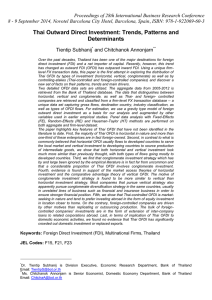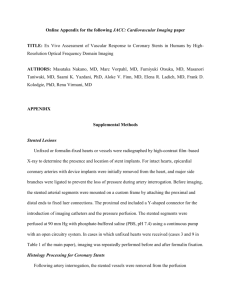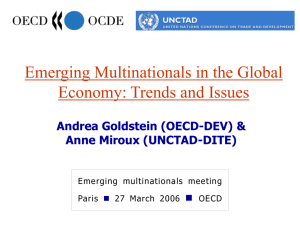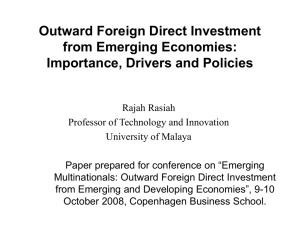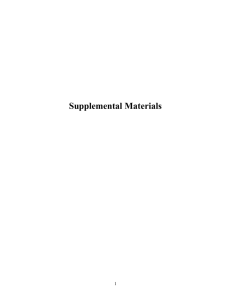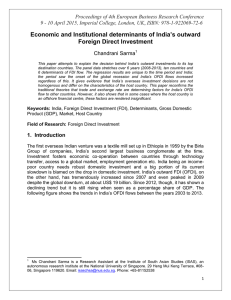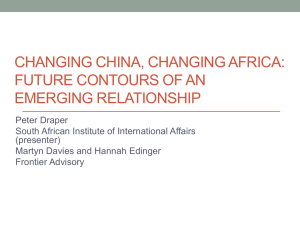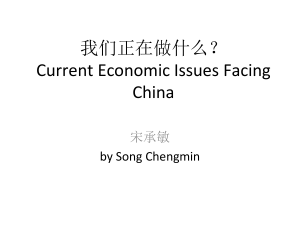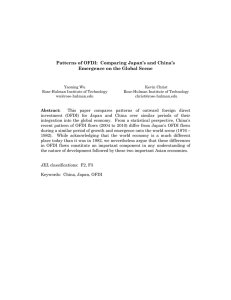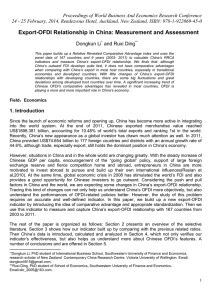Proceedings of 30th International Business Research Conference
advertisement
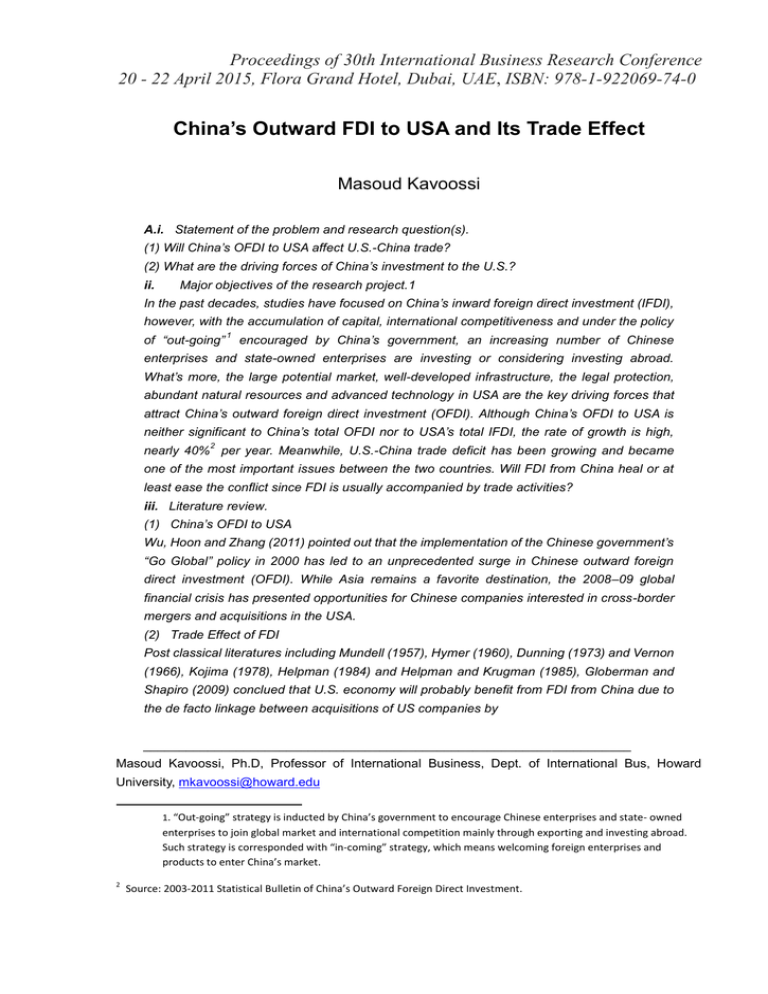
Proceedings of 30th International Business Research Conference 20 - 22 April 2015, Flora Grand Hotel, Dubai, UAE, ISBN: 978-1-922069-74-0 China’s Outward FDI to USA and Its Trade Effect Masoud Kavoossi A.i. Statement of the problem and research question(s). (1) Will China’s OFDI to USA affect U.S.-China trade? (2) What are the driving forces of China’s investment to the U.S.? ii. Major objectives of the research project.1 In the past decades, studies have focused on China’s inward foreign direct investment (IFDI), however, with the accumulation of capital, international competitiveness and under the policy of ―out-going‖ 1 encouraged by China’s government, an increasing number of Chinese enterprises and state-owned enterprises are investing or considering investing abroad. What’s more, the large potential market, well-developed infrastructure, the legal protection, abundant natural resources and advanced technology in USA are the key driving forces that attract China’s outward foreign direct investment (OFDI). Although China’s OFDI to USA is neither significant to China’s total OFDI nor to USA’s total IFDI, the rate of growth is high, 2 nearly 40% per year. Meanwhile, U.S.-China trade deficit has been growing and became one of the most important issues between the two countries. Will FDI from China heal or at least ease the conflict since FDI is usually accompanied by trade activities? iii. Literature review. (1) China’s OFDI to USA Wu, Hoon and Zhang (2011) pointed out that the implementation of the Chinese government’s ―Go Global‖ policy in 2000 has led to an unprecedented surge in Chinese outward foreign direct investment (OFDI). While Asia remains a favorite destination, the 2008–09 global financial crisis has presented opportunities for Chinese companies interested in cross-border mergers and acquisitions in the USA. (2) Trade Effect of FDI Post classical literatures including Mundell (1957), Hymer (1960), Dunning (1973) and Vernon (1966), Kojima (1978), Helpman (1984) and Helpman and Krugman (1985), Globerman and Shapiro (2009) conclued that U.S. economy will probably benefit from FDI from China due to the de facto linkage between acquisitions of US companies by ____________________________________________________________________ Masoud Kavoossi, Ph.D, Professor of International Business, Dept. of International Bus, Howard University, mkavoossi@howard.edu 1. “Out-going” strategy is inducted by China’s government to encourage Chinese enterprises and state- owned enterprises to join global market and international competition mainly through exporting and investing abroad. Such strategy is corresponded with “in-coming” strategy, which means welcoming foreign enterprises and products to enter China’s market. 2 Source: 2003-2011 Statistical Bulletin of China’s Outward Foreign Direct Investment. Proceedings of 30th International Business Research Conference 20 - 22 April 2015, Flora Grand Hotel, Dubai, UAE, ISBN: 978-1-922069-74-0 Chinese MNCs and the openness of China’s domestic economy to US trade and capital exports. The large size and rapid growth of China’s domestic market makes it a particularly beneficial partner for the USA. Morrison (2012) emphasizes that foreign investment often plays a major role in generating bilateral trade flows. Wei (2009) gathered data of trade and OFDI during 1995 and 2007, from three countries, USA, Hong Kong and Vietnam, to illustrate that when investing in more developed countries, China will have more significant impact on trade than others do. Patrie (1994) and Gray (1998) studied driving forces of FDI to classify FDI, Wu et al. (2011) indicate that Chinese companies are keen on the United States because of access to the world’s largest market and technology. Holtbrügge and Kreppel (2012) argue that gaining access to new markets is of utmost importance for all firms. Sui and Zhao (2012) 3 discussed that inverse gradient OFDI was mainly correspondent to strategy-oriented and market-seeking FDI. B. Research Design and Methodology i. Hypothesis (1) Bilateral Trade activities will be promoted after FDI (2) Trade effect is matched to specified driving forces ii. Research methodology Step 1- Trend analysis (Macro-level data) To understand the overall relationship between Sino-U.S. trade (import and export separately)and China’s OFDI to USA, we are going to draw a Line graph using country level data gathered from UNCTAD from year 1982 and 2011. Step 2- Case studies (Micro-level information) We are supposed to study the OFDI behavior of leading enterprises in detail by acquiring the answer to the following questions: (1) Do the enterprises import or export to U.S. before OFDI? Are trade activities and transaction amount promoted after OFDI? (2) What is direct export (import) related to the OFDI firm? C. Potential contribution of the Research i. Expected contribution to knowledge in the field. On the one hand, Most of the recent studies about China’s OFDI to U.S. focuses on firm level strategy instead of taking the trade effect from country level into consideration. On the other hand, those articles on trade effect seldom apply evidence from China’s OFDI to USA. This proposal will research evidence of China’s OFDI to USA from firm level but analyze the issue via country level—— the trade relationship between China and USA to address the puzzles 3 Inverse gradient indicates less developed countries invest in developed countries, such as China’s multinational corporations invest in USA. Proceedings of 30th International Business Research Conference 20 - 22 April 2015, Flora Grand Hotel, Dubai, UAE, ISBN: 978-1-922069-74-0 ―what kinds of enterprises are welcomed‖ and ―How can more China’s capital enter USA with less obstacles. ii. Timeline of research activities and expected date of completion of research Date Expected date of completion Jan, Review trend of China’s OFDI to USA, including total amount, 2015 rate of growth from year 1982 and 2011, industrial distribution, location distribution and type of enterprises. Know which leading enterprises in each industry are. Compose paper according to the results of investigation and analysis. Submit for peer review journal publication in int’l business April, 2015 Revise paper after peer-review and the feedback of experts.
